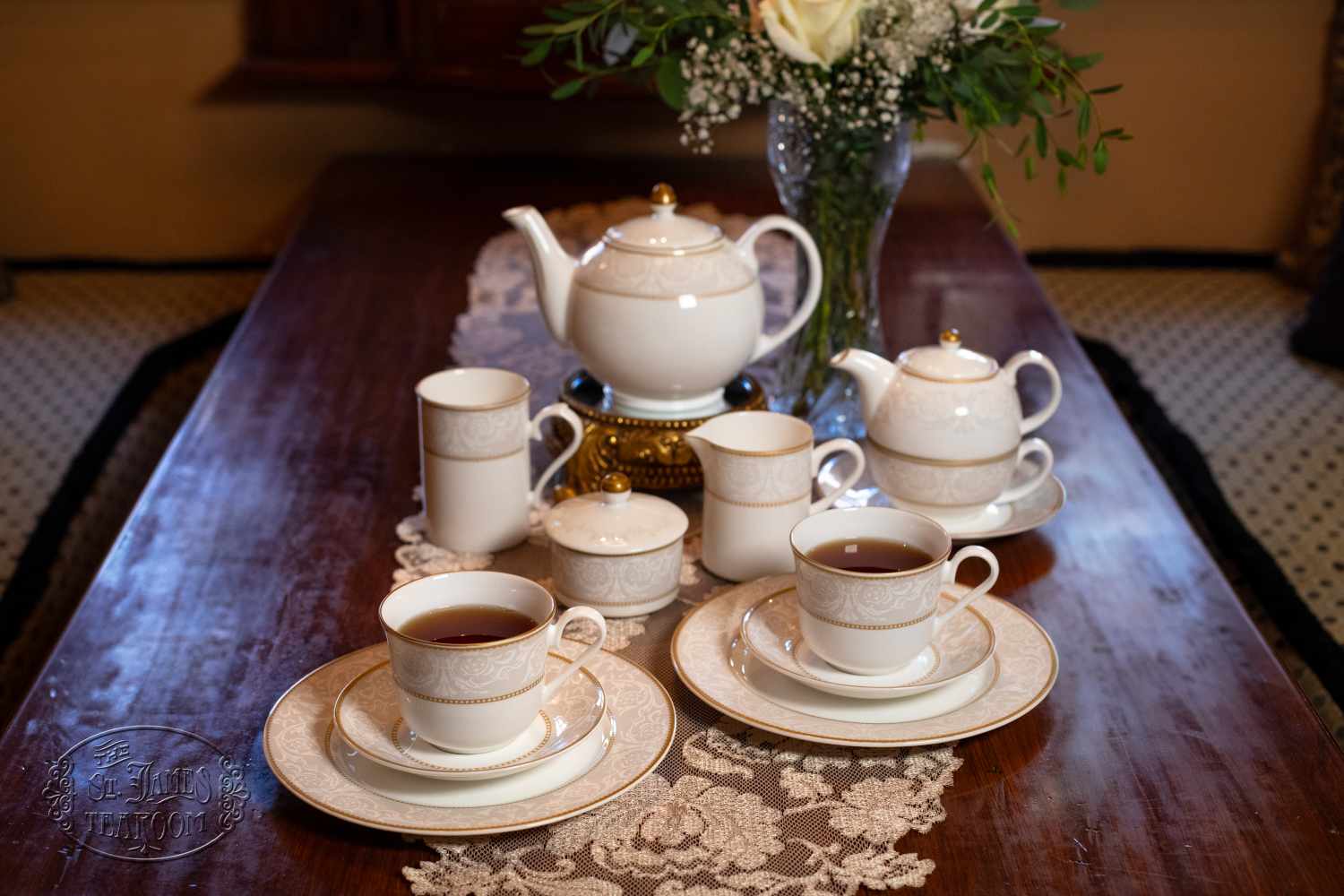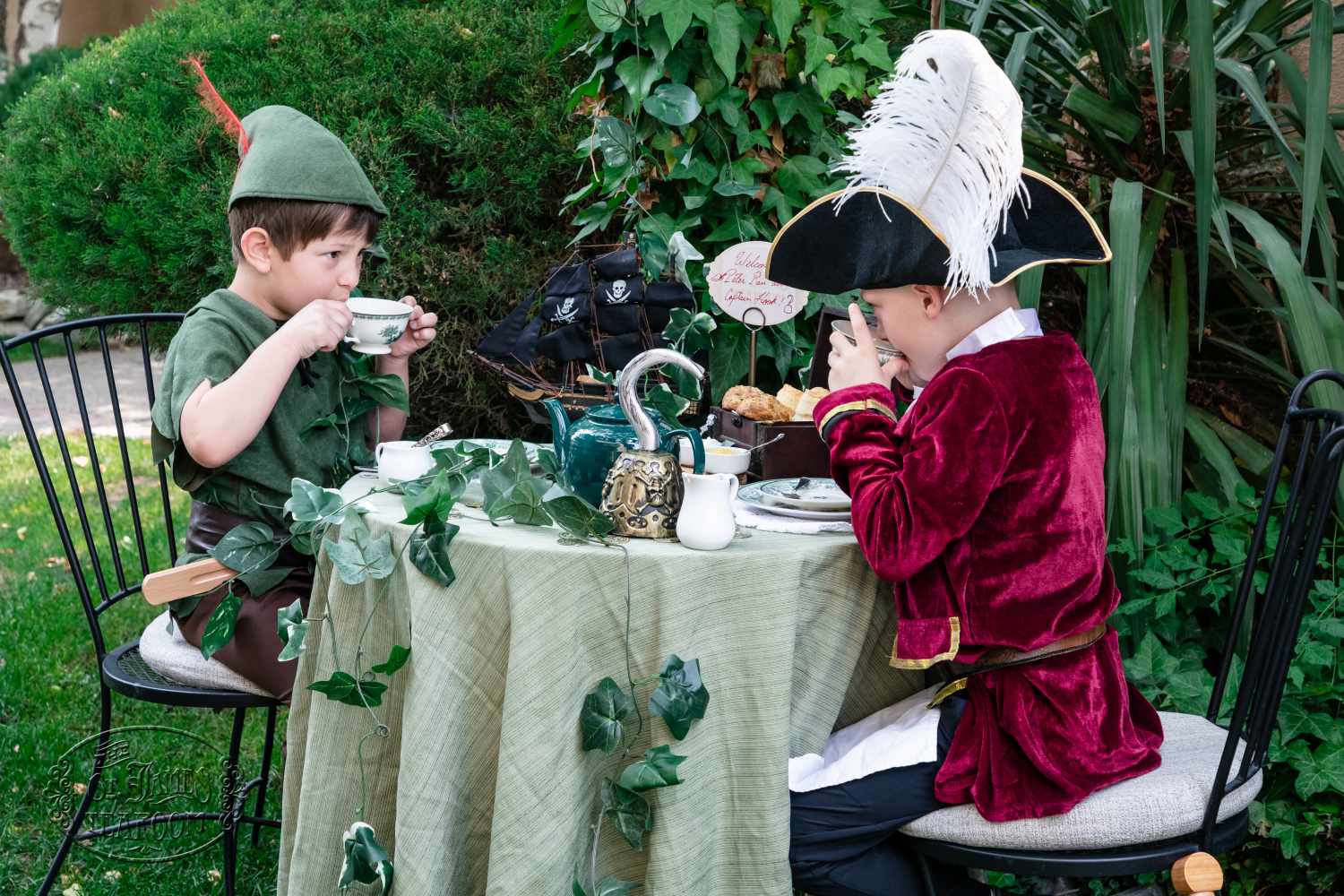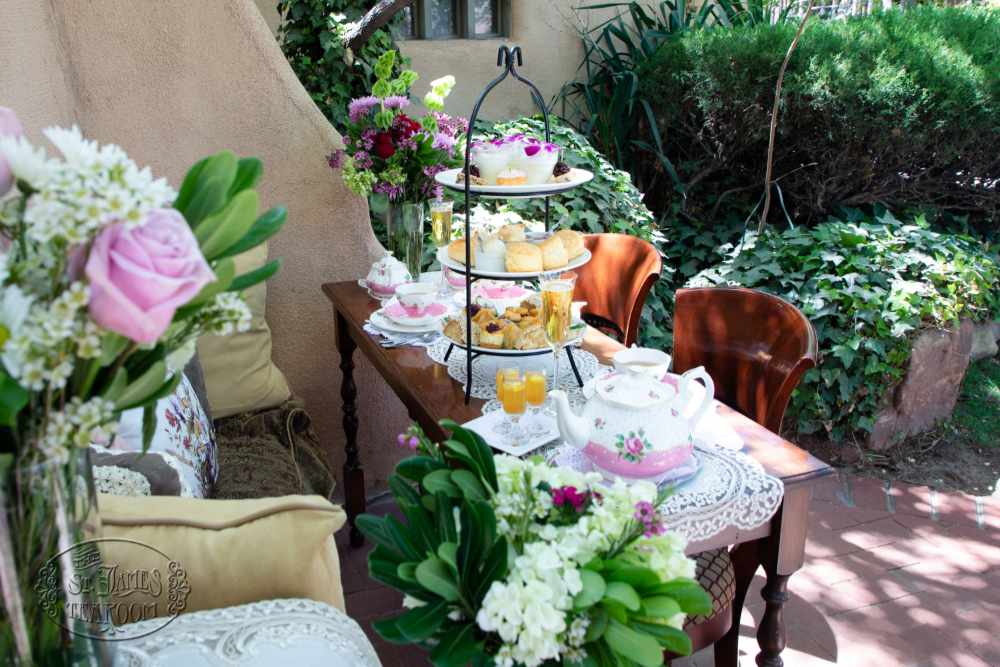
Butterflies and Tea
This guest blog is by New Mexico writer Patrice Greenwood, a long-time guest who has become a very special, personal friend. You will see her love of beauty here, and will understand afresh the joys of taking time to appreciate those ephemeral marvels that exist right alongside us, whether we notice and appreciate them or not.
For a number of years, I’ve made more-or-less annual visits to the Butterfly Pavilion at Albuquerque’s Botanic Gardens, always with a handful of friends, followed by tea at the St. James Tearoom. The Butterfly Pavilion is only open to the public during the summer season, starting in late May.
We arrive as the gardens open, before the heat and the crowds begin to increase. This year, along with the usual dozens of butterfly photos, I decide to take a photo of the pavilion itself. Here it is as we approach (left). Can you see it? It’s almost invisible, because it’s really just a wooden framework with netting for walls, tucked among the shade trees. It’s full of beautiful bushes and plants that butterflies love, making it a lush, cool, colorful place to spend an hour or so before tea.
 Visiting the Butterfly Pavilion is an exercise in conscious movement. We are met at the door by a docent who warns us that at this time of day, the butterflies like to sit on the ground, like this Red-Spotted Purple reposing in a patch of sunlight on the wooden walkway (right). The docents have been watering, and the butterflies love to sip from puddles or just rest on the damp earth and soak up the moisture.
Visiting the Butterfly Pavilion is an exercise in conscious movement. We are met at the door by a docent who warns us that at this time of day, the butterflies like to sit on the ground, like this Red-Spotted Purple reposing in a patch of sunlight on the wooden walkway (right). The docents have been watering, and the butterflies love to sip from puddles or just rest on the damp earth and soak up the moisture.
We pause just inside the entrance to orient ourselves. The Pavilion has height – over twenty feet – and depth in a sunken garden on the west side. This early, it is cool and quiet.
 At first, the butterflies may not be obvious, but stand still for a moment and focus on your surroundings, and soon you’ll see fluttering movement all around. Very likely you’ll spot a butterfly on a bush quite nearby, or perhaps one will drift past you on its way to a tasty flower. As you move through the Pavilion, you must watch every step you take, and be careful not to lean against anything – even the back of a bench where you are sitting – without first checking for butterflies, like this little Question Mark (left). Keep voices low, and move carefully to avoid startling the residents. If you’re patient, you can step right up to the bushes where they’re resting and get a good view, and take some photos if you’re inclined.
At first, the butterflies may not be obvious, but stand still for a moment and focus on your surroundings, and soon you’ll see fluttering movement all around. Very likely you’ll spot a butterfly on a bush quite nearby, or perhaps one will drift past you on its way to a tasty flower. As you move through the Pavilion, you must watch every step you take, and be careful not to lean against anything – even the back of a bench where you are sitting – without first checking for butterflies, like this little Question Mark (left). Keep voices low, and move carefully to avoid startling the residents. If you’re patient, you can step right up to the bushes where they’re resting and get a good view, and take some photos if you’re inclined.
 The most magical of sights – that of several butterflies fluttering in the same space at once – is impossible to capture in a still photo, alas. But there are plenty of good photo opportunities nonetheless. Here is an Erato Longwing enjoying a spray of bougainvillea blossoms (left).
The most magical of sights – that of several butterflies fluttering in the same space at once – is impossible to capture in a still photo, alas. But there are plenty of good photo opportunities nonetheless. Here is an Erato Longwing enjoying a spray of bougainvillea blossoms (left).
 The Pavilion provides a guide that identifies most of the species in the enclosure. The butterflies are hatched out in a small shed on the east side, where rows of chrysalises are pinned on boards awaiting the emergence of the beautiful creatures within (right). A little fan at the bottom of the window helps them dry their wings. Eventually, they come out into the Pavilion to enjoy their brief lives of beauty.
The Pavilion provides a guide that identifies most of the species in the enclosure. The butterflies are hatched out in a small shed on the east side, where rows of chrysalises are pinned on boards awaiting the emergence of the beautiful creatures within (right). A little fan at the bottom of the window helps them dry their wings. Eventually, they come out into the Pavilion to enjoy their brief lives of beauty.
Adult butterflies usually live from a week or two to a month, depending on the species. There are exceptions, such as those species that migrate or hatch in the autumn and winter over, but even those are with us for a relatively short time. So visiting them in the pavilion is a gift, a moment of ethereal, magical beauty that will never happen exactly the same way again. These tiny beings are probably unaware of the delight they give us.
 This sign (left) is one of several scattered around the Pavilion warning visitors not to touch the butterflies. Tempting as it may be to pet them, they are too delicate, and touching them can harm them. Their wings are so fragile that many of the butterflies you’ll see in the Pavilion have lost a wingtip or look a little frayed, just from bumping against the foliage. They are a visual beauty, to be enjoyed with the eyes, not caught or held. Within the Pavilion, they are privileged beings.
This sign (left) is one of several scattered around the Pavilion warning visitors not to touch the butterflies. Tempting as it may be to pet them, they are too delicate, and touching them can harm them. Their wings are so fragile that many of the butterflies you’ll see in the Pavilion have lost a wingtip or look a little frayed, just from bumping against the foliage. They are a visual beauty, to be enjoyed with the eyes, not caught or held. Within the Pavilion, they are privileged beings.
 We may not touch them, but they are allowed to touch us whenever they please! Hats with flowers inevitably attract them, of course, though they will not be fooled for long, and will wander away to the real flowers or the fruit on the feeding platforms set out for them.
We may not touch them, but they are allowed to touch us whenever they please! Hats with flowers inevitably attract them, of course, though they will not be fooled for long, and will wander away to the real flowers or the fruit on the feeding platforms set out for them.
On this visit, I believe every member of our party is landed upon by a butterfly at least once. I, myself, am privileged to have a Morpho ride around on my back for a while, which is pretty fun, although I can’t see it. Another Morpho settles on my spouse’s hip for a moment, and a little White Peacock lands on my hand while I am taking the photo of the sign!
The Morpho is my favorite butterfly, and it’s hard to photograph. It tends to close its wings at rest, and the undersides are rather plain-looking: brown with eye spots. When it flies, though, its open wings are iridescent blue! I took a few photos, but none were good enough to post, alas; however, my spouse captured a shot of the one that rode around on my back (left).
Morpho is actually a genus of butterflies, comprising many different species. Most of them are the same amazing iridescent blue. They have been prized by collectors for centuries. The ones in the Pavilion this year are quite large, as big as my hand!
 How many butterflies are in the Pavilion? I neglect to ask this question of the wonderfully helpful docents during our visit, but believe I’m not exaggerating when I say there are hundreds and hundreds. They are everywhere you look, everywhere you step, in the air, among the flowers. Sometimes they can be difficult to see, like these Julias sipping nectar from similar-colored blossoms (right), or this splendid green Malachite against the foliage (left, below). How many Julias do you see in the photo? Look closely (answer at the end of the journey).
How many butterflies are in the Pavilion? I neglect to ask this question of the wonderfully helpful docents during our visit, but believe I’m not exaggerating when I say there are hundreds and hundreds. They are everywhere you look, everywhere you step, in the air, among the flowers. Sometimes they can be difficult to see, like these Julias sipping nectar from similar-colored blossoms (right), or this splendid green Malachite against the foliage (left, below). How many Julias do you see in the photo? Look closely (answer at the end of the journey).
 After an hour or so of wandering around the Pavilion on a lovely June morning, it begins to get warm and the walkways become more and more crowded with visitors. (I warn my friends to be careful where they put their feet – they might step on a photographer!) It is time to say farewell to the Pavilion and think about tea. First, though, we want to visit the brand new High Desert Rose Garden.
After an hour or so of wandering around the Pavilion on a lovely June morning, it begins to get warm and the walkways become more and more crowded with visitors. (I warn my friends to be careful where they put their feet – they might step on a photographer!) It is time to say farewell to the Pavilion and think about tea. First, though, we want to visit the brand new High Desert Rose Garden.
Leaving the Pavilion involves another moment of conscious activity, as we check each other with the help of a nearby mirror to make sure we have no butterfly hitchhikers. Then it’s out into the gardens, and off to the roses.
If you know your way around the Botanic Gardens, head for the Japanese Garden. The High Desert Rose Garden, which has just opened, is on the way there. A nice big bed of established rosebushes is just outside the new garden, so pause there to enjoy them, for the rose bushes within are all brand new and not showing much in the way of flowers. Next year they should begin to flourish, and soon this new garden will be a delightful place to see and smell many varieties of roses. There’s a lovely building there which hosts a display of cut roses from the Albuquerque Rose Society. I can’t help but think this would be a perfect place to have tea.
 Today, though, we are bound for the St. James Tearoom. After more than an hour on our feet, we are happy to sink into the comfortable couches in the Bird and Baby, and enjoy tall glasses of water along with our tea. It’s the perfect ending to a perfect morning.
Today, though, we are bound for the St. James Tearoom. After more than an hour on our feet, we are happy to sink into the comfortable couches in the Bird and Baby, and enjoy tall glasses of water along with our tea. It’s the perfect ending to a perfect morning.
To me, a visit to the butterflies is naturally followed by tea at the St. James. It’s not just a habit, it’s a tradition, of the best kind. As we relax in the comfort of the tearoom, cooled by a fan that flutters like a butterfly’s wings, I recall past years of butterflies and tea. The friends, like the butterflies, are different each year, and yet the same. Always beautiful, always delightful.
(How many Julias did you find in the photo above? There are four.)
Patrice Greenwood was born and raised in New Mexico, and has been visiting the Albuquerque Botanic Gardens ever since they opened. She loves afternoon tea, old buildings, gourmet tailgating at the opera, and solving puzzles. Her latest novel in the popular Wisteria Tearoom Mysteries, A Bodkin for the Bride, will be released on July 14, 2015.






